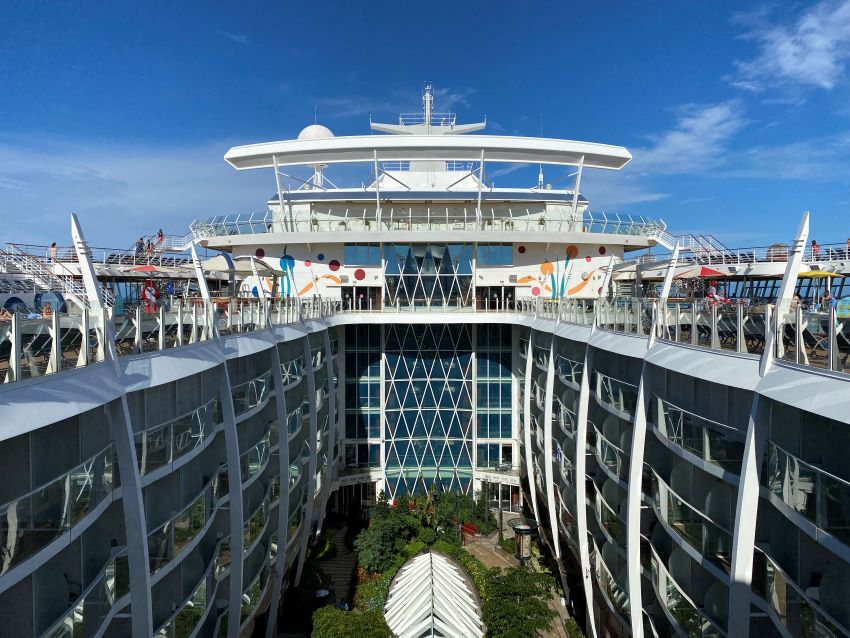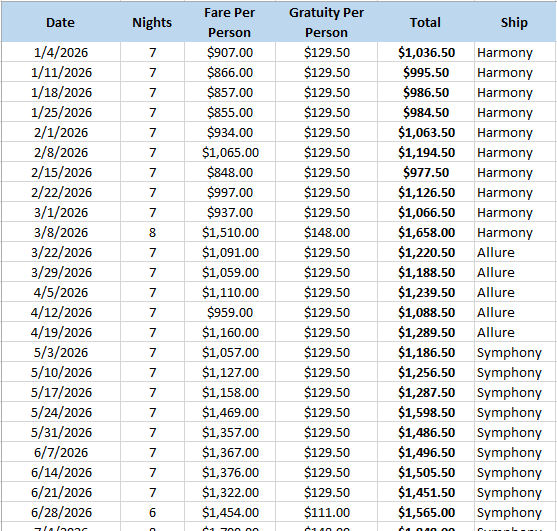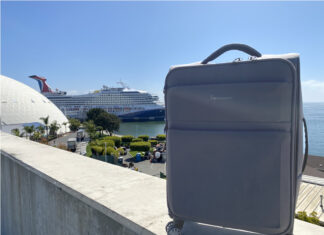Think of retiring, and you’re likely picturing a life of relaxing, traveling, eating good food, and with plenty of time to do whatever you want.
Come to think of it, that sounds an awful lot like taking a cruise.

On a cruise, not only do you get to enjoy yourself on the ship as you travel from port to port, but you also have your food, entertainment, housekeeping and more included. That makes it an ideal lifestyle for retirees.
You don’t have to worry about cooking or cleaning the dishes, mowing the yard, or calling a plumber. And given the relative affordability of cruise fares, it seems possible that you could get all of this for seemingly less than it would cost to live on land.
In fact, major news stories have covered retirees that have doing exactly that. Instead of having a traditional retirement, these people have opted to instead live their golden years on a cruise ship.
But how much would that actually cost? To be sure, it’s not cheap, but it might be less than you imagine. To give you an idea, we’ve decided to look at a real world example, pricing the cost of living aboard a ship using actual data from the cruise lines.
Here’s how much it would cost to live on a cruise ship in retirement.
Finding a Retirement Cruise
Anyone that’s taken a cruise — or even shopped for one — knows that what you pay can vary dramatically. There are dirt-cheap fares for interior cabins on budget cruise lines that start at a couple of hundred dollars. Then there are rooms that are nothing short of spectacular that can easily run thousands or tens of thousands for a cruise.
Prices can also vary based on the ship, cruise line, and time of year you’re sailing. In other words, there is a wide range of what you’ll pay to retire on a cruise.
So how do you come up with a price of what it might cost? For that, we decided to focus on an option that we think would appeal to the broadest amount of people by being a mid-tier cruise that’s realistically affordable without having to skimp.
We chose to analyze cruising aboard a moderately priced Royal Caribbean ship for a year. Specifically, we chose to price out the cost of sailing for a full year from Galveston aboard an Oasis-class ship. During 2026, Royal Caribbean ports Harmony of the Seas, Allure of the Seas, and Symphony of the Seas in the Texas town. Each ship takes a turn sailing from the island during the year.
These ships sail primarily 7-day cruises from Galveston, with some 6 and 8-day cruises thrown in for variety.

Oasis-class ships like these are among the largest on the planet with a wide range of restaurants, bars, things to do, and even Central Park if you’re craving some greenery while at sea.
There’s no doubt that one issue of spending a long time at sea — even on a cruise ship — is battling the boredom of being in a relatively contained space. With a ship like Harmony, Allure, or Symphony of the Seas, you have the closest thing to being in a small city without breaking the bank.
And since a retiree would be spending so much time on the ship, we priced a balcony cabin. Yes, you can sail for less money in an interior cabin, but that also means no light, no fresh air, and less space. A balcony is a nice compromise between having a little more comfort without spending up for a large suite.
So how much would this trip cost?
Cruise Fare/Taxes/Gratuities: $130,000+ Per Couple
Looking at every cruise these ships sail in 2026, we priced out the cost of a balcony cabin for each individual trip.
But anyone who buys a cruise knows it’s not just the cruise fare you have to pay. That’s why we also factored in the taxes and port fees and the automatic gratuity. And remember, if you book a cruise cabin, it’s normally sold on the basis of double occupancy. That means you are charged for two people, even sailing solo. But more than that, we find it more likely that someone retiring on a cruise ship would do so with a partner.
Now this isn’t all that you’ll spend if you decide to retire on a cruise (more on that in a moment), but it represents the bulk of what you’ll pay. In total, we calculate living aboard this ship would run a starting cost of about $136,000 a year for two people — or roughly $68,000 per person.
That comes out to about $370 per day for a couple traveling together and includes cruise fare, taxes, and gratuities.
For that amount you’d get your room, entertainment, and food taken care of, along with housekeeping.
Note: Due to a scheduling quirk as ships change out in Galveston, there are two weeks where an Oasis-class ship doesn’t sail. Our figures below are based on 351 sailing days, or 50 weeks in the year.
Additional Spending to Remember
If you've sailed before, then you know that the cruise fare -- while being the largest portion of what you'll spend -- is also just part of the cost of taking a cruise. There are also expenses like onboard spending and days in port.
The good news is that unlike the cruise fare, you have complete control over these spending items. Don't want to spend a dime? You can do that (although it seems somewhat unrealistic).
For reference, Royal Caribbean Group -- across all of its cruise lines -- reports onboard revenue as roughly $93 per person, per day according to SEC filings. That means for a 7-day cruise, the "average" passenger would spend approximately $650.
Of course, that figure comes from the average passenger who is living it up on vacation and likely spending more on a daily basis than a retiree would on a ship. For instance, we don't think someone living on the ship would be buying drink packages, gambling every day, or eating in the specialty restaurants on a daily basis.
In our estimation, a figure of half that -- about $45 per person, per day -- would be more likely. That comes out to roughly $32,500 a year for a couple.
What about spending in port? Again, a retiree visiting a port would spend very differently than someone visiting on vacation. Drinks, shore excursions, and souvenirs likely aren't on the menu. Instead, we imagine a person wanting to visit a pharmacy, grocery store, or have lunch off the ship for a change of pace. In that case, we think a total of $8,000 per person ($16,000 per couple) over the course of the year should be plenty for a retiree managing their budget.
Other Costs to Consider (Non-Cruise Related)
While we've focused on the cost of retiring aboard a cruise ship, you'll notice that we've only given figures related to the actual cruise itself. However, there are other expenses -- and logistics -- that you should consider about retiring on the ship.
For one, healthcare is a major factor to consider. For retirees on Medicare, the service doesn't cover care outside of the U.S. For that reason, it's a good idea to have regular trips from a homeport in case you need to see doctors. There is medical care on the ship, but it's designed for short-term care, not continual medical treatment.
As well, even while on the ship you will have additional costs on land. For instance, do you plan to keep a residence back home? Monthly notes, rent, maintenance, taxes and other costs will be a factor to consider.
Even if you sell your home to live full-time on the ship, renting storage space for any belongings you can't bring on the ship will add up.
Bottom line: No doubt that the cruise fare and associated spending will be the biggest expense in retiring on a cruise ship, but don't forget about additional costs.
How to Retire on a Cruise for Less Money
Still want to retire and live a life at sea but the costs shown here are a little too rich for your savings? There's no arguing that spending nearly $200,000 a year to live a life on a cruise ship is steep for most people. The good news? You can trim costs considerably with these ideas:
Opt for Less Expensive Lines/Ships: For this example, we priced out cruises aboard one specific ship from Royal Caribbean. However, there are lines that are less expensive and older ships that cruise for cheaper. Checking other options could result in saving tens of thousands of dollars over the course of a year.
Retire "Part-Time" at Sea: Cruise fares fluctuate widely during the year. If you sail during the busy summer season, the same cruise can be hundreds of dollars more than in the fall or winter. If you want to save money, you can use this to your advantage. So book cruises during the low season and retire at sea. But then find alternate arrangements during the busy summer months to save considerably.
Watch the Onboard/Port Spending: As mentioned, your onboard spending is the one area where you have the most control. By watching your dollars here, you can keep from adding considerably to the annual costs of retiring on a cruise. That may not be as much fun as living it up like you're on vacation every day, but we'd rather budget while living on a cruise than not being able to sail!







I have been considering this option. We currently rent so no mortgage, etc to also deal with. Along with no utilities! Just a good cell phone plan. No need to pay for our two vehicles and insurance. Taxis, Uber, Lyft etc work or a car rental would replace them and cheaper than car payments and insurance, tags, etc. No need for furniture, appliances etc. Anything that is precious that I don’t need with me can go into storage or given to my kids now. We very rarely drink and personal services can be arranged near the home port and most other ports. We buy more groceries than we need for 2 people and end up wasting it, throwing money away. You can go to laundry mats in many ports if needed. And ports where the USD is worth more is where you’d pick up needed supplies. I’d make arrangements with a relative or friend near our home port to receive our mail/packages and use as legal residence. I just think it wouldn’t cost much more than what we spend currently and that we’d live as well if not better.
This is an increasingly popular option as on-land accommodation in big cities and big countries becomes out of reach and unaffordable for the majority of the population. I would emphasise that there are multiple ways to reduce expenses greatly: e.g., [a] Inside Cabin is less than half the cost of a Balcony Cabin and you can get FREE access to massive decks 24/7 far bigger than any balcony and floor-to-ceiling windows in multiple venues on a ship bigger than any in-room views; [b] the higher up the loyalty-programme you go with Royal Caribbean, the CHEAPER cruises become: e.g., discounts on drinks, internet, laundry and dining…leading to FREE drinks, internet-services, laundry, etc. [c] Older ships are far cheaper than new ships and mega-ships: e.g., Icon of the Seas could cost U.S.$4,000 for just one week in an Inside Cabin but that same money could buy a MONTH on an old ship in the same fleet.